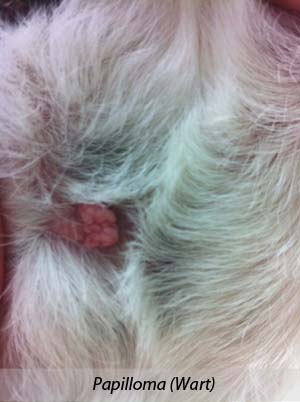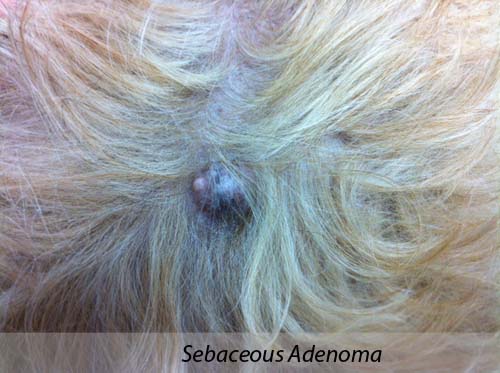> Today we're going to discuss warts, or papillomas, which is the medical term for warts.
>
> Papillomas are benign clusters of abnormal cells caused by the papilloma viruses, a group of DNA viruses that cause proliferative cauliflower-like skin and mouth lesions in dogs. These viruses tend to affect three groups of dogs: young dogs who get outbreaks of oral papillomatosis, immunosuppressed dogs, and older dogs who grow warts as they age.
>
> 
>
> It's assumed all dogs have been exposed to the papilloma viruses. But because all canine papilloma viruses are opportunistic, they only flare in bodies with immune systems that aren't 100 percent healthy.
>
> There's no breed or sex predisposition to the development of papillomas, so immune system function is really the determining factor in whether or not your dog develops warts.
>
> The good news is canine warts do not affect other species. There's no need to worry about you, the cat, or your kids catching the canine wart virus.
## Papillomatosis in Young Dogs
> The form of the condition young dogs usually acquire is oral papillomatosis, where the oral cavity and sometimes, but rarely, the mucous membranes of the eye develop warts. These wart clusters often have a fleshy, cauliflower-like appearance. The virus is spread by direct contact between dogs, which often happens when they lick each other or greet one another.
>
> The virus can also spread in other ways – through insect bites, cuts, scrapes, or where there's inflammation present in your dog's body. But certainly, oral contact is the most common means of transmission among dogs.
>
> Canine oral papillomatosis typically occurs in dogs under two years of age because they are immunologically naïve as compared to adult dogs. A young dog's immune system is immature and inexperienced, so he's more likely to develop papilloma lesions because his body isn't yet capable of mounting an effective immune response to eliminate the virus.
>
> Canine oral papillomatosis in young dogs often spontaneously regresses after a few months when the immune system eventually kicks in, recognizes the problem, and resolves all the oral warts.
>
> In severe cases of oral papillomatosis when dogs are suffering from congenital immunodeficiency, the body may not recognize an immune response is required. So there is a massive viral infection and the lesions in the mouth don't heal. These poor puppies can have hundreds of warts in their mouth that make it nearly impossible to eat or drink without excruciating pain.
>
> In these cases, a topical medication called imiquimod has been used to help boost immune-mediated inflammation, and thus facilitate destruction of the virus by the body. The antibiotic azithromycin has also been proven to help resolve oral lesions within 15 days. But I only recommend using these medications if the dog is not eating and her quality of life has been compromised.
>
> Pups with oral papillomatosis should remain quarantined or separate from other dogs until all lesions have resolved.
## Papillomatosis in Aging and Immunosuppressed Pets
> The other categories of dogs that acquire papillomas are older pets with aging immune systems or pets given immunosuppressive drugs such as glucocorticoids like prednisone. Any drug that suppresses the immune system may encourage the papilloma virus to flare up.
## Diagnosing Warts
> Diagnostic testing isn't necessary in most cases, as most vets recognize the classic appearance of papillomas. Because warts are benign, my rule of thumb is to remove them only if they're causing quality of life issues for the pet. This means if the dog is repeatedly chewing or scratching the wart until it bleeds, or if a wart is between the toes and causing the dog to limp.
>
> One thing it's important to know about warts is they only grow to a certain size, and then they stop. A single wart is not going to grow large enough to take over a dog's whole body.
>
> If any skin lesion seems to be growing or changing, it's worth a visit to your veterinarian for a checkup. In very rare cases, a wart can turn into a cancerous skin lesion called squamous cell carcinoma. These lesions don't stop growing or changing. Any skin lesion that is dynamically or continually changing should be closely monitored by both you and your vet. But as I mentioned, this type of wart is quite rare.
>
> If you'd like a definitive diagnosis, I recommend you ask for a fine needle aspirate of the growth, which means your vet will remove some cells and confirm it's a benign epithelioma – a wart.
## Treating Warts
> Unfortunately, many veterinarians play on the fear pet owners have of cancer with remarks like, "Ooh, it could be something spooky. We're not quite sure what it is." And many veterinarians recommend that all skin lesions, even benign skin tags and certainly benign papillomas, be surgically removed. After all, the veterinarian makes good money removing these benign skin tags and warts. The owners have bought themselves some piece of mind.
>
> It's important dog owners recognize that many aging pets, in addition to having viral papillomas, can develop non-viral benign skin tumors as well. These are called sebaceous adenomas and epitheliomas. Although they are not virally induced, they're still essentially harmless in most cases, and don't tend to cause problems.
>
> 
>
> I prefer taking Dr. Pitcairn's approach to warts, which is to use them as an immune function barometer of sorts.
>
> Because warts are usually painless and only annoying to owners, I recommend using the development of warts to monitor a patient's immune health. Remember, removing warts doesn't remove the virus from your dog's body. Unless the immune function problem is addressed, his body will continue to produce warts.
## The Vaccine-Wart Connection
> Vaccines have been implicated as a cause of papillomatosis. This is another reason I don't recommend over-vaccinating pets. Often warts are an indication the animal has received too many vaccines, or has had a negative reaction to vaccines.
>
> Ironically, the homeopathic treatment for warts is the very same homeopathic treatment for vaccinosis, which is a remedy called Thuja. Needless to say, eliminating or reducing the number of unnecessary vaccines your pet receives is a great first step in reducing the potential for papillomatosis. Continuing to vaccinate can often bring about another flare up of warts.
>
> Most veterinarians assume all dogs have been exposed to the papilloma virus. The goal is to keep your pet's immune system healthy by reducing vaccines, feeding a low-stress diet, and providing clean air and water and a chemical-free living environment.
**Related Articles:**
 _place_holder; [What's That Strange, Scary Lump?](http://healthypets.mercola.com/sites/healthypets/archive/2011/08/02/whats-that-strange-scary-lump.aspx)
 _place_holder; [When NOT to Remove These Scary-Looking Lumps and Bumps...](http://healthypets.mercola.com/sites/healthypets/archive/2011/08/09/when-not-to-remove-these-scarylooking-lumps-and-bumps.aspx)
 _place_holder; [The Canine Cyst You Should NEVER Squeeze...](http://healthypets.mercola.com/sites/healthypets/archive/2011/08/16/sebaceous-cysts.aspx)
[** _place_holder;Comments _place_holder;(16)](http://healthypets.mercola.com/sites/healthypets/archive/2012/10/01/dog-warts-treatment.aspx?ShowAllComments=True#comments)**
URL: http://healthypets.mercola.com/sites/healthypets/archive/2012/10/01/dog-warts-treatment.aspx

No comments:
Post a Comment